Martin Edwards's Blog, page 21
August 28, 2024
The Killer - 2023 film review
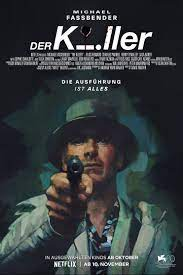
I must admit my heart sank a little when, having opted to watch a recent film directed by the estimable David Fincher, I realised that The Killer was based on a graphic novel, which isn't necessarily a recipe for a story of any depth. My doubts were compounded when the film began very slowly indeed - clearly a deliberate decision on Fincher's part, but I felt he overdid it. Fortunately, things began to improve and, although the story is oddly episodic, several of the set-piece scenes were truly gripping.
The film opens with an assassin philosophising in a room in Paris as he prepares to shoot a target. There's nothing terribly original about his various mantras ('Trust no-one' etc) and things drag strangely before finally he shoots - and misses his intended victim. Perhaps the philosophising distracted him, who knows? He makes a hasty getaway and is next scene in the Dominican republic, where it turns out he has a hideaway. Unfortunately someone has been there and tortured his girlfriend, who somehow manages to survive.
The rest of the film sees the assassin pursuing vengeance against the people responsible. So it's a pretty straightforward story, but it has some very interesting moments, for instance in an encounter with a corrupt lawyer and his secretary. The assassin uses an ever-changing variety of aliases (using the names of characters from American sitcoms) and there's a fight scene against the background of an episode of Antiques Roadshow, starring Fiona Bruce. These sporadic touches of humour offer some relief from the bleakness of the protagonist's worldview and meticulous execution of his plans. I also very much liked his encounter in a restaurant with a woman known as 'the Expert', played by Tilda Swinton; a cameo part, yes, but she does a great job. The ending of the film is surprisingly ordinary, but somehow (and I don't say this as a criticism) that's in keeping with the mood of the lead character.
Michael Fassbender makes a very good assassin, conveying the right level of believable menace and attention to detail. I don't think The Killer is as compelling as Fincher's best films, but after that iffy start it certainly kept me interested.
August 26, 2024
The Guest - 2014 film review
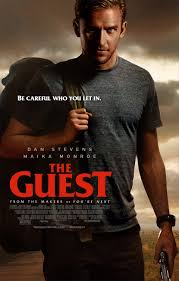
The storyline of The Guest is a mash-up of home invasion thriller, conspiracy thriller, and Halloween thriller. There is plenty of violence and some points in the plot aren't entirely clear (apparently there was more explanation in the original version, but this was cut after preview audiences felt it was long-winded). Really, it should be a mess. But although it has trashy elements, it's surprisingly watchable.
This is in part due to the fact that the protagonist is played by Dan Stevens, who is quietly-spoken and charming, but with a faint undercurrent of menace. One day he turns up out of the blue at the home in New Mexico of a grieving family, the Petersons. He explains to Laura Peterson (Sheila Kelley) that his name is David Collins and that he was the best friend of Caleb, the Petersons' son, a soldier who died recently in the Middle East. She invites him to stay for a while and he meets her husband Spencer (Leland Orsler), their gay son Luke (Brendan Meyer) and their daughter Anna (Maika Monroe). At first Spence and Anna are hostile towards him, but he gradually wins everyone's confidence.
But it's clear almost from the start that David is not as nice as he seems. In particular, he has an extreme propensity for serious violence and a disturbing talent for manipulating people. I thought the film was heading in a fairly conventional direction, but then came a significant plot development which changed my perception of what was going on. But it would still have been good to know why David really went to the Petersons' house, and what exactly made him behave the way he did. By cutting down the explanation, I think the director threw the baby out with the bath water.
Even so, I found this film fairly gripping, in a sort of guilty-pleasures way. A twist right at the end of the movie left the door open for a sequel, which was apparently contemplated, but never actually made. Don't expect anything too sophisticated from The Guest, but there's a reason why it was well reviewed. It's well-paced and a perfectly good time-passer.
August 25, 2024
New Books
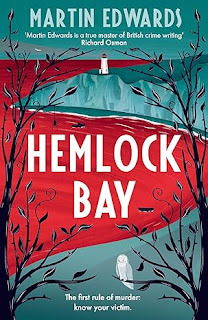
I'm excited to say that the coming days will see the publication of three of my books (plus a fourth in America), with my fifth and latest Rachel Savernake novel, Hemlock Bay, leading the way. I really enjoyed taking Rachel and Jacob Flint to the seaside in this mystery, and I'm very much hoping that readers will delight in one of my most intricate stories, which is published by Head of Zeus under the Aries imprint. There's a Cluefinder, as in earlier Rachel Savernake books, and this one contains no fewer than forty-seven clues - see how many you can spot before Rachel reveals all!
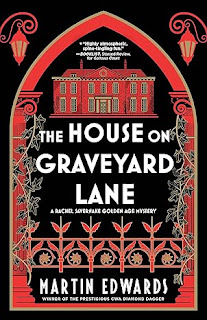
The previous book in the series is just being published by Sourcebooks in the United States. This is The House on Graveyard Lane, known in the UK as Sepulchre Street. As part of the celebrations around the launch, I took part in an interview with Barbara Peters of the legendary Poisoned Pen bookstore and it can be found here
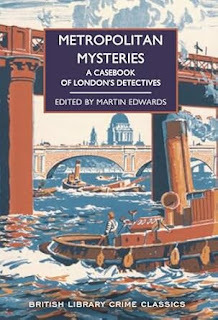
Returning to England, September 10 sees the publication of my latest anthology in the British Library's Crime Classics series. This is Metropolitan Mysteries, subtitled A Casebook of London's Detectives, and it features stories by luminaries such as Henry Wade, Dorothy L. Sayers, and John Dickson Carr, as well as some unfamiliar names, including Malcolm Gair. I aim to include both familiar and deeply obscure stories in these themed collections and there are some genuine rarities here.
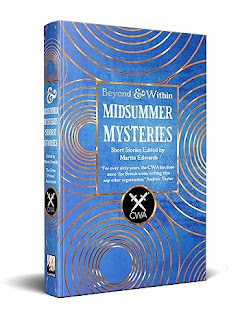
Last but by no means least comes Midsummer Mysteries, which I have edited on behalf of the Crime Writers' Association. The publishers, Flame Tree Press, have come up with a quite gorgeous volume. In stark contrast to the British Library book, this is a collection of brand new stories and more than half of them are written by people who have never previously had a short story in a CWA anthology, which I find quite remarkable. Among those stories is one of my own, 'The Widow, which is set in Berwick-upon-Tweed, and was partly inspired by my visit to the Berwick Festival last year. But the story is set in the Sixties and concerns an idea which has interested me for a very long time..
August 23, 2024
Forgotten Book - The Five Red Herrings
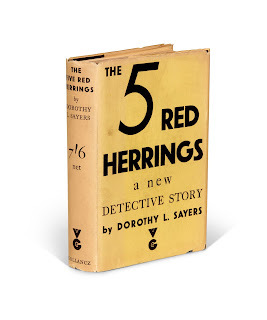
After my visit to Galloway, it seems only right to devote today's retrospective to Dorothy L. Sayers' The Five Red Herrings, although it is very far from a forgotten book. Indeed, I doubt it has ever been out of print. The book was originally called Suspicious Characters in the US and sometimes the definite article is omitted from UK editions, as it was when the story was adapted for television by Anthony Steven almost half a century ago.
Sayers agonised over the title - quite rightly, she cared about her titles and hers were usually memorable. She wanted to call this book Six Suspects, but someone beat her to it (long before Vikas Swarup wrote his bestseller with that title). In fact, I think she finished up with a very good title, whether or not you include the definite article.
Her intention was to write a puzzle plot story, a whodunit with strong leanings towards the Freeman Wills Crofts style of mystery. While she was working on the book, she was in touch with Crofts - a fellow founder member of the Detection Club - and learned to her dismay that he was working on a book set partly in the same area of Scotland. This was Sir John Magill's Last Journey, which I reviewed The two stories are very different, however, and Sayers was determined to ensure that her publisher gave her a better map of the area than appeared in the Crofts title. She got her way, naturally.
The great strength of this novel lies in its evocation of the artists' colony and the way of life in what is still a relatively traditional community. Sayers took pains over the construction of her puzzle, as she took pains over all her creative endeavours, but I'm afraid it's not a compelling mystery. Constructing a whodunit wasn't her forte - she was a very, very different writer from her friend Agatha Christie. The TV version is in many respects an improvement on the book. Nevertheless, the story offers a wonderful illustration of her ability to conjure up a believable and compelling setting.
August 21, 2024
On the Trail of The Five Red Herrings

During my recent trip to Scotland, I was keen to trace some of the locations which crop up in Dorothy L. Sayers' 1931 novel, The Five Red Herrings. Set in Galloway, this book is a love letter to the area and the prefatory note (addressed to Joe Dignam, landlord of the Anwoth Hotel in Gatehouse in Fleet, to whom the book is dedicated) spells out her commitment to writing about real places.

The main focus of my pilgrimage was Kirkcudbright. As Sayers says in the book, in this part of the world one either fishes or paints, and painting is at the heart of the novel. What I found very interesting is that Kirkcudbright was a mecca for artists long before Sayers and her husband Mac Fleming (an Orcadian who loved painting) arrived there on holiday. And that tradition continues. In the twenty-first century, when you drive in, there is a sign which proclaims the fact that you are entering an 'Artists' Town'.

Galleries abound, and I enjoyed looking at the exhibition devoted to the portrait painter Sir Henry Raeburn at Kirkcudbright Galleries, an impressive space which has plenty of other interesting material on permanent display. There's another nice little gallery at the Harbour Cottage, while it was fun to walk down High Street and pass the door of the No. 14a, which Mac Fleming rented for ten years up to the start of the Second World War. A stone's throw away is Broughton House, once owned by the artist E.A. Hornel and now in the care of the National Trust of Scotland. The house featured in the 1975 TV version of Five Red Herrings, as did a number of other places in the town.

From Kirkcudbright, it's not far to Gatehouse of Fleet, where Dorothy and Mac stayed at the Anwoth Hotel, now called The Ship Inn (below). This is another attractive town which benefits from a waterside setting and as I wandered around the area, it was good to picture Sayers roaming about, in search of inspirations for her story. She found plenty of good material, that's for sure.

August 19, 2024
On The Trail of The Wicker Man

I'm just back from a shortish but enjoyable break in the south west of Scotland, mainly devoted to visiting an old friend from my school days, but incorporating plenty of fun trips and making the most of lovely weather - other than one very wet morning spent in the delightful book town of Wigtown! And even that damp day was made extremely pleasurable by the experience of wandering around the shops. Wigtown is a pleasant place, make all the pleasanter by the presence of thousands of books. I'd like to give special mention to Well Read Books, run by Ruth Anderson K.C. (not a bad career move for a top barrister to start up a great bookshop!) who was most welcoming. The shop has an eclectic stock, with some marvellous - and very uncommon - old crime titles as well as new books. I snaffled a John Rhode paperback that I'd never even seen before, and I'll definitely be back.

The first stop, though, was the seaside town of Ayr, which has lovely beaches and plenty of history. From there it was a short drive to Culzean Castle, which I last visited more than thirty years ago. It's a place that has stayed in my memory for various reasons, including the fact that in the film of The Wicker Man, it was the home of Lord Summerisle, also known as the great Christopher Lee.

Culzean is a National Trust property, an impressive house in splendid grounds overlooking the sea. In the film, of course, it is located on the verdant island of Summerisle. The film was shot in a variety of locations in the south west of Scotland, and I enjoyed wandering around the area and seeing a number of them.The monster in the Swan Pool seen below is not connected with the film, nor is the horse shown at the end of this post, but I liked them a lot...

In the pretty little town of Kirkcudbright, the tourist information shop (situated close to the woven horse shown below) even sells pamphlets which show several of the locations used in the film. The harbour cottage now houses an art gallery and the whole area is picturesque. One evening, we dined in the Creebridge House Hotel, where members of the film crew stayed during the shoot. On a gorgeous day, it's hard to imagine that this area is the setting for one of the finest horror movies ever made. But of course, it's that contrast between light and dark that makes for such powerful artistic effects.

August 16, 2024
Forgotten Book - Fearful Symmetry
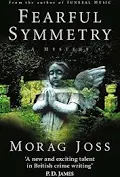
I've mentioned Morag Joss a couple of times over the years. First, in relation to her excellent novel Half Broken Things (which gets a name-check in The Life of Crime) and the and second when reviewing another of her novels of psychological suspense, . As a writer, she is a class act. I've never met her, so I can't be sure of this, but my guess is that she finds writing crime fiction slightly constricting. And this may help to explain why she is far from prolific in the genre, despite having achieved considerable success.
I've now read her second novel about the cellist Sara Selkirk, Fearful Symmetry. It seems rather characteristic of Morag Joss's somewhat off-beat approach that her protagonist is a cellist and also that she opted for a title which is intriguing but unusual. This is definitely a crime novel, and Sara does plenty of amateur detecting (with mixed results) as well as collaborating with a policeman, Andrew, who just happens to be in love with her. I felt that in some respects Sara and Andrew were rather irritating, but in a sense that just illustrates the fact that they are well-rounded characters. As are most of the other key players in the story.
One of the great strengths of this novel is its wit - sometimes seasoned with irony. There's also some poignant writing. One character is on the autistic spectrum, a subject in which I've become very interested, and the presentation of autism is well handled, especially when one bears in mind that the book was published 25 years ago, when this complex condition was less well understood.
The opening scene is devastating. We are introduced to a single, retired woman called Imogen Bevan. She is respectable but unpleasant (and in fact she is quite harshly presented) and her unkind nosiness has truly shocking consequences. The investigation, led by Andrew, meanders for a long time, especially given that the reader knows something that the police don't know, and in the meantime we're introduced to Sara and an assorted bunch of people who become involved in a community opera project. A successful but vain composer is portrayed with biting satire, as is another, rather less renowned composer. And eventually a second shocking death occurs. Again the inquiry is handled in a rather desultory way but the finale is gripping and memorable.
This was Morag Joss's second crime novel and it isn't without flaws. The digressions are wonderfully written, but there are a lot of them, and the balance between story development, characterisation, and discussion of music, is uneven, which affects the pace adversely. But even though some aspects of life have changed a lot in the quarter-century since this book first appeared, it remains true that good writing is good writing. And there is a plenty of that in Fearful Symmetry, as well as a story that I think will linger in my mind.
August 14, 2024
The Innocent - 1993 film review
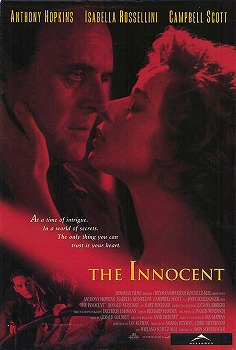
I'd never heard of the 1993 film The Innocent before it turned up on Talking Pictures TV. When I discovered that it was a spy movie set during the Cold War and not only directed by John Schlesinger but with a screenplay written by Ian McEwan and based on his novel, I was definitely interested. And when I learned that the cast was headed by Anthony Hopkins and Isabella Rossellini, it became a must-watch.
I wasn't disappointed, either. The film isn't a masterpiece, and you could argue that the whole isn't as great as the sum of its individual parts. This is partly due to some curious casting decisions, but the fact that fine actors are involved means that they meet the challenges head on and, overall successfully. The script is something of a slow-burn, which is also perhaps a weakness. But again, by the time the end credits rolled, I felt McEwan had done a good job.
The setting is Berlin in the mid-50s and a British telecoms expert arrives in the city to help the Americans to spy on the Russians with the help of state-of-the-art equipment hidden in a tunnel beneath the Russian zone of the city. I spent a week in Berlin in the 70s, when the Cold War was still ongoing, and the film brought back some memories of that very atmospheric trip.
The British guy, Leonard, happens to be played by an American, Campbell Scott (son of the more renowned George C. Scott) and the tough American who tells him what to do is played by Wales' own Anthony Hopkins. Leonard involves himself with a glamorous German woman (played by an Italian, Isabella Rossellini), so it's certainly a multi-national enterprise. There's an extended quasi-Hitchcockian sequence involving suitcases with highly compromising contents that is quite memorable, though overall the mood is low-key. The Innocent is as much a character-led drama as it is a story about espionage (or, indeed, a murder mystery), but it's well worth watching.
August 12, 2024
Malice - 1993 film review
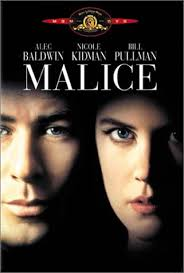
Malice is a well-known film, released over 30 years ago, but it's taken me a long time to get round to watching it. When I did, I found it twisty if improbable, and it certainly benefits from the quality of a cast that includes Anne Bancroft in a memorable if minor role as well as George C. Scott and Gwyneth Paltrow in smallish, but significant, parts. The key roles, however, are those of Nicole Kidman, Alec Baldwin, and Bill Pullman.
The screenplay by Aaron Sorkin and Scott Frank uses as minor ingredients plotlines that, in other hands, would be central to a movie. At first, this seems to be a story about a serial killer who is targeting young female students. Pullman plays Andy Safian, an academic at a local college who is recently married to Tracy (Kidman at her most glamorous). He is briefly a suspect after one of his students (Paltrow) falls victim to the murderer. But we know he's innocent.
There's a separate strand involving a charismatic doctor, Jed Hill (Baldwin), who is new to the area. He turns out to be an old school colleague of Andy's and when Andy invites Jed to stay in the house he and Tracy have acquired, we start to wonder if this might be some kind of home invasion thriller, especially given that Andy seems to have his eye on Tracy. But no, that's not what this film is about.
Tracy's medical problems turn out to be central to the storyline. This is, however, definitely a film in which nothing is as it seems. There are quite a few plot holes, when you come to think about it afterwards, but the pace of the action is enough to disguise some at least of the improbabilities. So while Malice isn't a masterpiece, it's a pretty effective light thriller, still just about good enough to keep me engrossed after all this time.
August 9, 2024
Forgotten Book - A Perfect Match
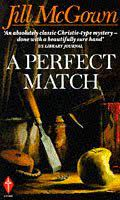
I started reading Jill McGown's books, back in the late 1980s, and out of chronological order. Finally I've reached back to her debut novel, A Perfect Match, which introduced her cops Lloyd and Hill, and appeared in 1983. Here she reunites the duo, who have been interested in each other when working in the past, but have complicated things by being involved in other relationships. But it's clear that the spark between them is going to ignite...
I've only just realised as a result of reading this novel that, in some ways, this relationship is comparable to that between Hannah Scarlett and Daniel Kind in my own Lake District books. I can imagine that Jill had no detailed plan as to how the relationship would develop, just as I didn't - although I was clear in my mind that their connection would steadily turn into a romantic one. But there are various differences, including the setting and the link between Hannah and Ben Kind. Plus, Daniel isn't a cop at all. He's interested in the past, which Hannah researches in her own way as she tries to solve cold cases.
A Perfect Match is in many ways typical of the style that Jill McGown evolved over the years - a domestic scenario with a limited cast of characters and hidden relationships and affairs. The writing is crisp and unfussy, rather like that of Peter Robinson and Ann Cleeves, who came along a few years later and wrote in roughly the same tradition.
This is an enjoyable detective novel which remains a good read more than forty years on. A lie is told by a married couple at the start of the story which I found fairly implausible, but overall I felt that for a first novel this was a very mature piece of work. Jill McGown had real talent and her early death was a sad loss.



